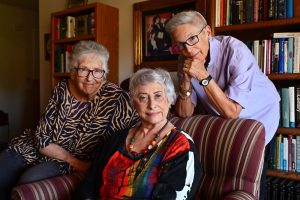Could Santa Clara County’s use of unlicensed foster youth group homes — the scenes of runaways, assaults, a drug overdose and alleged rape — lead to criminal charges? State authorities already threatened as much last year, new documents obtained by this news organization show.
Child-welfare advocates say the county should face consequences for failing to appropriately license long-term housing of its most troubled and vulnerable children to ensure proper review and safety, which the Bay Area News Group revealed in May.
“This idea that they’re sending them to fly-by-night places that are unregulated is tragic and horrible,” said Dr. JeoffryGordon, a member of a state citizens advisory board that reviews child abuse cases. “It’s irresponsible to the max. It’s a crime.”
The county said in a statement last week that it has “faced major obstacles and challenges” from state overseers and blamed the state in part for “years-long licensing processes for critically needed” foster care services.
But Santa Clara County District Attorney Jeff Rosen, who’s taken strong stands concerning vulnerable children and recently charged a couple with murder after their child overdosed on fentanyl at their house, told the Bay Area News Group he’s eyeing the situation closely.
“We will pay close attention for any developments that weigh upon the safety of our community’s children,” Rosen said in a statement Monday. “If we discover a crime has been committed we will not shirk our duty.”
Counties across California have grappled with caring for high needs foster children since 2015 when the state legislature adopted landmark child welfare reform intended to place foster youths with relatives and foster families instead of group homes. That led to scores of group homes across California closing by 2019 — including a Santa Clara County shelter called the RAIC that was riddled with problems.
But since then, Alameda, Contra Costa and San Francisco counties all have developed, with the help of private providers, fully licensed “short term residential therapeutic program” group homes.
In Santa Clara County, however, private providers either couldn’t meet the state requirements or backed out of providing such services, and the county didn’t develop any of its own. Instead, without enough willing foster families, the county leased private homes around the county, called scattered sites, and without state approval opened them to the most troubled youth.
The California Department of Social Services, which regulates child care facilities, in 2020 called the county’s unlicensed group homes for foster children “unlawful” and said they “must cease.”
On Aug. 9, 2023, the state Department of Social Services sent a letter to the county’s Department of Children and Family Services director, Damion Wright, saying the county was violating the California Health and Safety code and its “continued operation without a license could result in civil and/or criminal action.”
In a Sept. 1 letter of response, Wright said the county had been working “diligently” to address the shortage of placement options, but that youth in the scattered sites are “extraordinarily challenging (if not impossible) to place.” The scattered sites, he said, have a “distinct therapeutic milieu” with staff trained in crisis intervention and therapeutic services available to youth.
But the threat spurred the county’s Department of Family and Children’s Services to file paperwork to formally license three remaining scattered sites in San Jose and Morgan Hill. After a visit last month by a state inspector, they are in the final stages of becoming licensed.
But the license the county is seeking only allows children to stay for three days — 10 days with a waiver. Already, children, ages 12-17, have been routinely living there for weeks if not months. In a report last year, the county’s Juvenile Justice Commission doubted the county could comply with the terms of short-term licenses.
“Even when the sites are licensed,” the commission said, “youth will stay significantly longer than three days, as the County simply does not have enough homes for high acuity youth.”
The county’s “Welcoming Center,” the first stop for neglected or abused children, is licensed to take in youths for no more than 24 hours. It sometimes keeps older children for weeks — which the county acknowledged to this news organization, blaming a “statewide shortage of placements for high-need children.”
It’s unclear how much more patience authorities will have. The state Department of Social Services said in a statement to this news organization that it “has not issued fines and continues to work with the county.”
In a May 30 memo updating the county Board of Supervisors on the scattered sites, Daniel Little, director of the county Social Services Agency that established the homes in 2020, said the county is actively recruiting more “intensive care” foster families to serve as a better landing spot for these high-needs children. The county now has contracts to increase the number of beds in those settings from 17 to 33, he wrote.
But Little also said the county is only “exploring” the development of fully-licensed “therapeutic” group homes that neighboring Bay Area counties have had in operation for at least four years. Little called for new state legislation to “empower counties.” He declined to comment.
The county in its statement defended the scattered sites.
“With limited options for the highest need youth in our care, the County created home-like environments supervised by DFCS staff who have devoted their professional lives to serving children in our community,” the county said. “But even though these homes have created a better option for youth in our county, we and other counties must do more to improve care for children with extreme behaviors and needs who are rejected by all other potential placements.”
Without state oversight, however, there are few inspections, so it’s unclear what level of care is actually being provided, child welfare advocates say.
“If they’re not regulated, there’s not accountability,” said Steve Baron, a member of the county’s Child Abuse Prevention Council who still holds the state largely responsible for the housing shortage crisis. “I don’t know how they got away with it for so long, except they’ve got nowhere to put these kids.”
Supervisor Joe Simitian, who in 2019 signed off on an “essential agreement” with the state promising the county would properly care for its high-needs foster children, blamed the state.
“My expectation was that the county would get to ‘yes’ sooner than later,” Simitian said. “Clearly that hasn’t happened.”
Supervisor Cindy Chavez said she is “absolutely not” pleased with the current situation. But it was unclear what further steps the board, which employs the county executive who oversees social services, might take.
“Am I impatient about it? One-hundred percent, the same way I would be if this were my kid,” Chavez said.
Gordon said the board needs to turn up the heat, “shake up” the social services agency and find a full-time “champion” to follow through.
“When the county bureaucracy doesn’t do what it’s responsible for, there’s nobody to pick up the ball and say, Wake up, folks,” Gordon said. “You’ve got a job to do here.”












